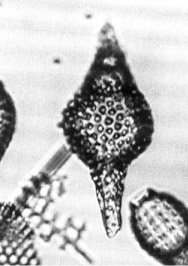 Eusyringium
fistuligerum (Ehrenberg)
Eusyringium
fistuligerum (Ehrenberg) Eusyringium
fistuligerum (Ehrenberg)
Eusyringium
fistuligerum (Ehrenberg)Eucyrtidium fistuligerum Ehrenberg, 1873, p.229; 1875, pl.9, fig.3.
Eusyringium fistuligerum (Ehrenberg), Riedel and Sanfilippo, 1970, p.527, pl.8, figs.8-9; Foreman, 1973, p.435, pl.11, fig.6
Cephalis thick-walled, subspherical, with very few small pores, bearing a thick conical spine with rough surface, approximately as broad at the base as the cephalis itself. Collar stricture indistinct. Thorax thick-walled, pyriform in early specimens to almost fusiform in some later specimens, with circular pores that are larger distally than proximally. Occasionally, the thorax bears three inconspicuous wings proximally. In some specimens, a stricture separates off the narrower proximal part of the thorax. [The distal part of the thorax] narrow, tubular, of variable length, with irregular subcircular pores and wall that is thinner than that of the [proximal part of the] thorax in early specimens and similar to that of the [proximal part of the] thorax in late specimens. In late specimens the junction between [the two parts of the thorax] is obscure, the one merging imperceptibly into the other (Riedel and Sanfilippo, 1970).
Length (excluding tubular prolongation) 135-255 µm, maximum breadth 60-150 µm.
The inflated thorax is distally prolonged as a narrow latticed tube (Riedel and Sanfilippo, 1978a) Eusyringium fistuligerum is distinguished from its ancestor E. lagena by its [narrow latticed tube]. Forms with a narrow, very thin-walled terminal tube are assigned to E. lagena. E. fistuligerum differs from Rhopalocanium ornatum Ehrenberg (1847b) by lacking the feet and distinct lumbar stricture (Sanfilippo et al., 1985).
The thick-walled thorax is pyriform with a delicate tubular prolongation in early forms, and changes to almost fusiform in later forms, to inflated fusiform at the end of its range. Occasionally the thorax bears three inconspicuous wings proximally. In some specimens, a stricture separates off the uppermost small fraction of the thorax. This stricture is variable in its development. The terminal tubular prolongation is variable in length, its wall being somewhat thinner than the proximal thoracic wall in early specimens but similar in late specimens (Sanfilippo et al., 1985).
This form is found in tropical localities of late middle to early late Eocene age. It has not been found at DSDP Site 283, near Tasmania. It evolved from Eucyrtidium lagena within the Podocyrtis ampla Zone. Its morphotypic last appearance lies within the Calocyclas bandyca Zone.
Eusyringium fistuligerum evolved from E. lagena by development of the tubular prolongation of the thorax. It apparently left no descendants.